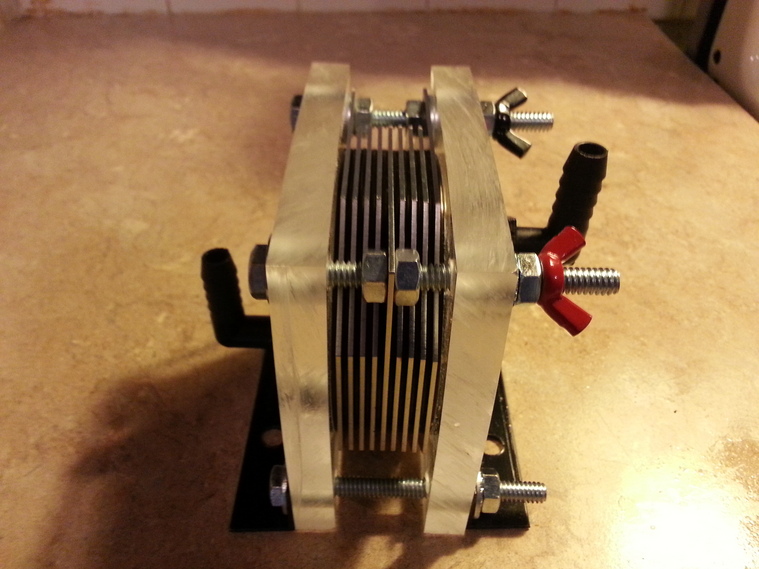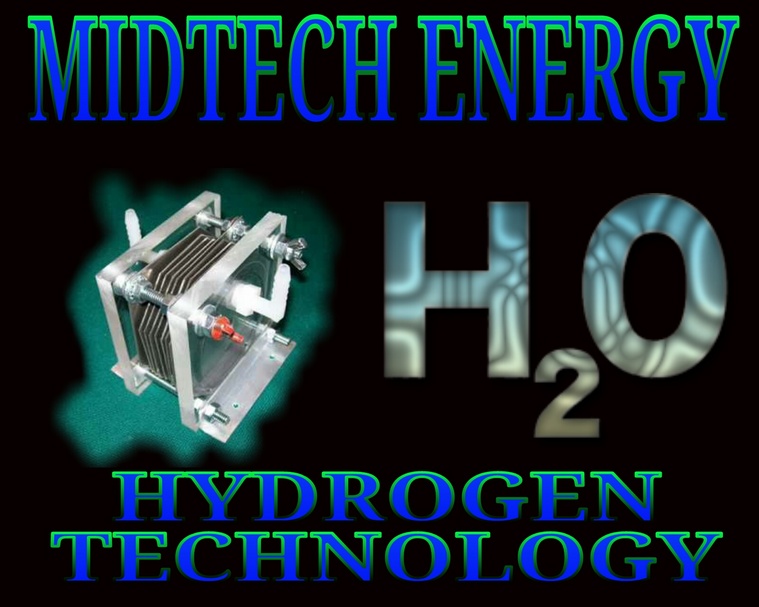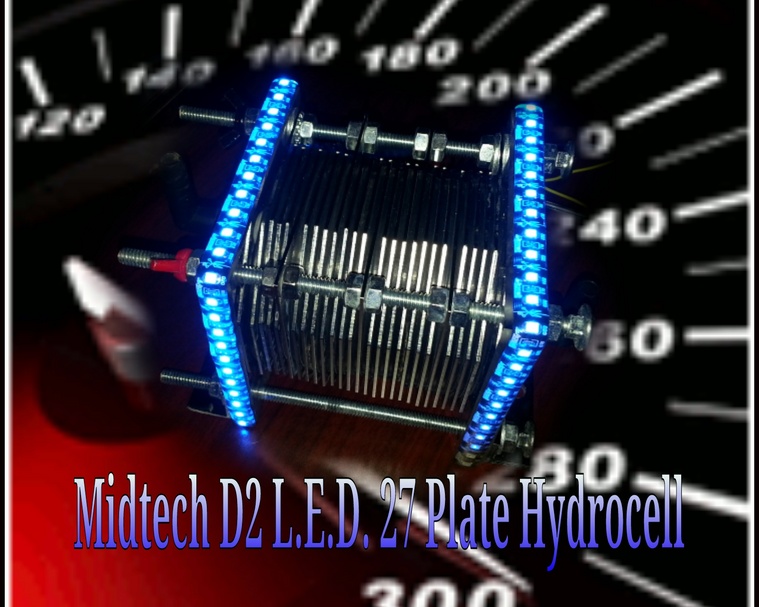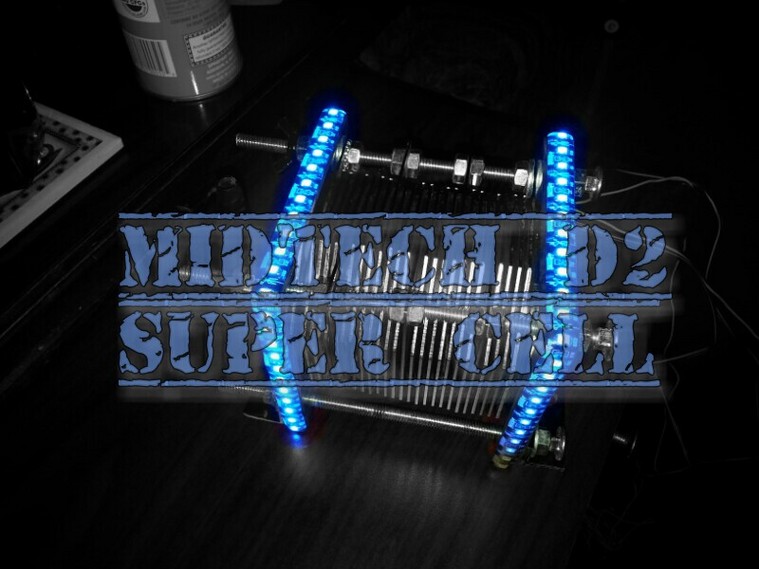MIDTECH ENERGY SOLUTIONS IS THE LEADER IN THE HYDROGEN CELL NATION. OUR HHO DRY CELLS ARE BY FAR THE BEST ON THE MARKET THAT PRODUCES RESULTS. OUR KITS COME COMPLETE READY TO INSTALL AND USE. UNLIKE OTHER INTERNET KITS THAT WANT TO SELL YOU PLANS FOR A HHO KIT OR SELL PARTIAL KITS AND YOU HAVE TO BUILD THE REST. THERE IS A REASON THAT MIDTECH IS THE NATIONS LEADER IN HHO TECHNOLOGY. ALL OF OUR HHO KITS ARE HIGH OUTPUT UP TO 2 LITRES PER MINUTE AND HAVE BEEN PRESSURE TESTED. WE ONLY USE HIGH QUALITY AMERICAN MADE PARTS TO ASSEMBLE OUR KITS. OUR KITS ARE SO RELIABLE AND EFFICIENT THAT THEY HAVE BEEN DUBBED MOTOR MOONSHINE KITS. THAT IS ACTUALLY A PHRASE WE ARE PROUD OF. IF OUR CUSTOMERS ARE SO SATISFIED WITH OUR PRODUCT TO GIVE IT A NICKNAME THEN WE ARE OKAY WITH THAT. BECAUSE CUSTOMER SATISFACTION IS A TOP PRIORITY TO US.
This is for one Complete HIGH OUTPUT HHO Cell Kit. This kit comes completely assembled and has all the parts you will need to connect the hydrogen cell to your vehicle. I challenge you to find a HHO cell complete kit that will produce this much HHO gas for a cheaper price. We use the same technology that NASA uses for their space shuttle program. If it works for NASA it will work for your vehicle just on a much smaller scale.
Note to potential buyers: if you are about to make your first purchase of a HHO generator this kit is an execellent choice. It is inexpensive, it works, and it will give you the opportunity to find out if using a hydrogen generator on your engine is something you really want to put the time and effort in to do. Hydrogen cells require periodic maintenance and must be taken apart and cleaned every 4000 to 5000 miles driven. Our Fuel Cells will not rob your vehicle of any power completely the opposite it actually makes your vehicle run smoother and perform better.
When HHO is ingested by an engine, the HHO burns as a self-contained fuel, supplementing and replacing a certain amount of gasoline.
Parts:
A simple HHO dry cell system is comprised of nothing more than an HHO dry cell and the requisite plumbing. The HHO dry cell contains a stack of metal plates (with every other one connected to a positive or negative battery source) submerged in water. As electricity tries to bridge the small gap between those plates, it must pass through the water and break its molecules, producing HHO. The HHO passes through a tube connected to the engine intake, where it's siphoned off by engine vacuum.
Opposition:
Science says HHO dry cells should not work. Science also says a bumble bee cannot fly. Gasoline provides the power to produce the electricity needed by the HHO dry cell. Because the HHO gas produced by the cell doesn't contain as much energy as the gasoline used to make it, HHO opponents claim there is physically no way for them to increase fuel mileage. On paper, HHO opponents are absolutely right; the math just doesn't add up. I am not one to take someone at their word. I am a test and see kind of guy and when I tested I saw!
Explanation:
While the HHO dry cells effectiveness is proven in many applications, its proponents are faced with the sticky question of how you can get more energy from a fuel than you put into it. One explanation is that alternators make an excess of power, and that the generator only utilizes what's wasted, but there are two better ones. The first is that because HHO gas is simpler in construction than the gasoline molecule, it burns faster and acts as a catalyst to ignite the gasoline sooner and more completely. Another is that the mixture's pure oxygen content allows more of the gasoline to burn, which also increases efficiency. HHO also combusts at a higher rate than gasoline so HHO allows you to use more of your fuel. A combination of extra energy being on vehicles and the fact that on average vehicles are only 66% efficient make HHO a perfect fuel assist.
The bottom line is HHO is combustible. What is the one thing you need in a fuel? COMBUSTION!
There are a lot of myths floating around about HHO (hydrogen-hydrogen-oxygen) dry cells, but the biggest myth of all is that they don't work.
How Does HHO Work on My Car?
It's very simple. Our HHO Dry Cell uses 12 volts of electricity from the engine and produces HHO gas (hydrogen + oxygen). You won't change or modify your engine. On newer cars with electronic fuel injection, the ECU (car computer) will have to be tuned as part of the HHO installation. The HHO gas is then supplied to the engine's intake manifold or carburetor as shown in the diagram below. The technology is simple, effective and safe. It takes about a 2 to 3 hours to install.
The science behind HHO is well documented. In 1974, Houseman and Cerini of the Jet Propulsion Laboratory (JPL), California Institute of Technology (CIT), prepared a report for the Society of Automotive Engineers (SAE) entitled “On-Board Hydrogen Generator for a Partial Hydrogen Injection Internal Combustion Engine”.
Also in 1974 at JPL, CIT, Hoehn and Dowy produced a report for the 9th Inter society Energy Conversion Engineering Conference, entitled “Feasibility Demonstration of a Road Vehicle Fueled with Hydrogen Enriched Gasoline”. The Hoehn and Dowy research included on-board storage tanks to supply the hydrogen enhancement.
There now exists a long history of studies and papers documenting the beneficial affects of HFI. Since the early studies in 1974, there have been ongoing studies and testing of HHO principles and applications. You will find an oft-cited list of these on many HHO web sites. More notable among these is a 1995 study and paper from the University of Birmingham, UK, “Fractional addition of hydrogen to internal combustion engines by exhaust gas fuel reforming” where the process yielded benefits in improved combustion stability and reduced nitrogen oxides and hydrocarbon emissions.
California Environmental Engineering (CEE) has tested this technology and found reduction on all exhaust emissions. They subsequently stated: “CEE feels that the result of this test verifies that this technology is a viable source for reducing emissions and fuel consumption.”
The HHO process is effective with any fossil fuel (diesel, gasoline, propane, natural gas) or bio-fuel (bio diesel, ethanol). Among other, subtler effects, the presence of the hydrogen alters the initial stages of the unfolding combustion dynamic, altering the kinetic chemical pathway that the combustion follows. The net effect is to alter the time at which heat energy is released relative to the power cycle. The end result is to increase the adiabatic efficiency of the engine. In layman’s terms, this means increased fuel efficiency, decreased emissions, improved horsepower and torque and decreased maintenance expenses.
Our HHO Dry Cell is Hydrogen on Demand. The HHO Dry Cell Kit can be installed on gasoline or diesel engines. According to engine size and range specifications, the Kit consists of One or Two HHO Dry Cells, a Bubblier/Reservoir Tank, Fuel hose, and a Amp Meter to monitor the electrical power delivered to the HHO Dry Cells.
Our HHO Dry Cell generates Hydrogen through electrolysis. The HHO Dry Cell Conversion Kit uses distilled water and a dissolved Electrolysis formula, which is used to speed up the electrolysis process. Hoses connected to the bottom of the Reservoir/Bubblier Tank carry the Electrolysis Additive solution to each HydroCell. The Electrolysis Additive solution flows into the HHO Dry Cell. There electrolysis of the water produces Oxygen and Hydrogen gas. The separated Oxygen and Hydrogen gases, flow upward from the HHO Dry Cell and into the Reservoir/Bubblier Tank.
The Oxygen and Hydrogen gases diffuse out of the bubblier Tank through a hose attached at the top and are drawn into the vehicle’s air intake system. The Oxygen and Hydrogen enter the engine’s combustion chamber, and mix with the fuel. The introduction of Hydrogen into the combustion chamber creates a more efficient, complete combustion, thereby increasing fuel efficiency while at the same time reduces emissions and increasing power and performance. On average every vehicle on the road is around 66% efficient. Adding HHO to your air intake system increases this to right at 100% efficiency. This is how you get your 30% MPG increase.
How Does Our HHO Dry Cell Reduce Pollution?
Our HHO Dry Cell reduces vehicles fuel consumption over all by creating a more efficient combustion cycle. In other words you use all of your fuel.
A more efficient combustion cycle allows you to use less fuel at the same throttle setting. But, the efficiency increase allows a lower throttle setting for a given horsepower production and therefore reduces fuel consumption for traveling a given distance.
It also, by burning hotter, consumes other material in the cylinder such as excess lubricants and carbon residue thereby resulting in cleaner engine combustion chambers as well. When HHO is not in use the extra unused fuel going through engine is known as blow by. This is the engine gunk which forms on your pistons. This blow by which does not get used goes out your exhaust as HydroCarbons.
What about Hydrogen Safety?
HydroClubUSA Conversion Kits Consume Hydrogen AT THE POINT OF Production, thereby eliminating all of the problems of generating Hydrogen at a remote location, storing it, distributing it, storing it again until it is sold, and then storing it on-board the vehicle where it is to be used.
In Summary…
The science is simple. HHO burns more rapidly than fossil fuels (gas, diesel or propane). With more efficient and complete combustion occurring, the HHO Dry Cell Conversion Kit offers significant reductions in exhaust emissions, and significant increases in fuel efficiency. You receive better performance while releasing significantly fewer pollutants into the atmosphere. Here at MIDTECH we strive to improve HHO dry cell technology everyday.
Doug Myers
Owner/Founder
MidTech Energy Solutions




















keywords - hho, hydrogen, generator, fuel cell, fuel
cells, free gas, water, hydrogen fuel cell, hho fuel cell, hydrogen fuel cell
cars, what is a fuel cell, generators, helium, hho generator, electric
generator, fuel cell generator, portable generator, home generator, fuel cell
cars, hydrogen generator, fuel cell technology, hydrogen fuel cell
car


Midtechs New D2
Hydrogen Fuel Cell
Available Now
Hydrogen Fuel Cell
Available Now


